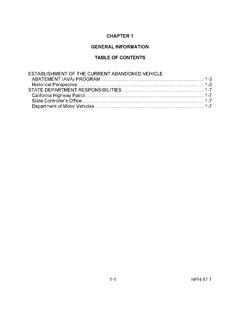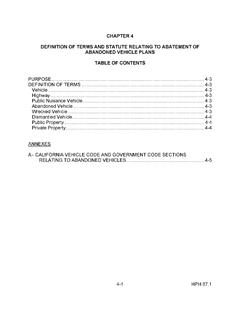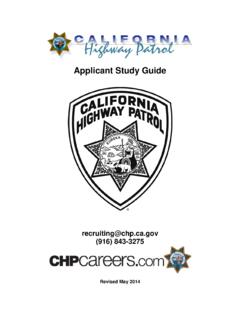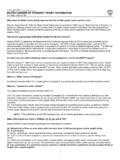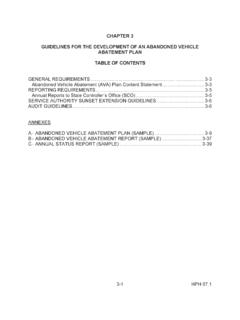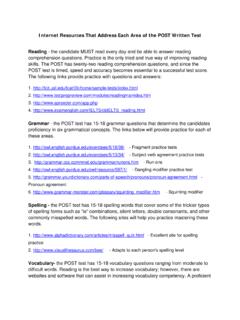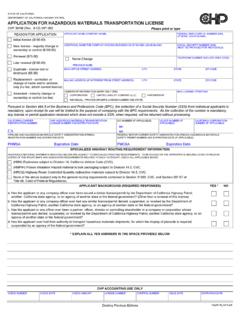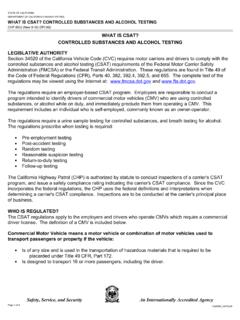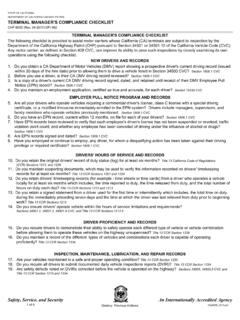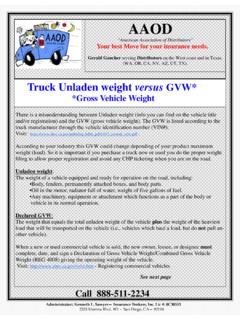Transcription of DEPARTMENT OF CALIFORNIA HIGHWAY PATROL …
1 Previous EditionsSTATE OF CALIFORNIA DEPARTMENT OF CALIFORNIA HIGHWAY PATROL WELCOME TO BIT, THE BASIC inspection OF TERMINALS (BIT) PROGRAM CHP 800H (Rev. 10-16) OPI 062 Safety, Service, and SecurityAn Internationally Accredited Agency Welcome to BIT The Basic inspection of Terminals (BIT) Program Introduction terminal inspections have been conducted by the CHP since 1965 as a tool to determine if motor carriers are complying with Motor Carrier Safety regulations, particularly with regard to the legal requirement to maintain commercial motor vehicles according to a scheduled maintenance (preventive maintenance) program. The CHP's role is to determine whether carriers' selected maintenance schedules are adequate to prevent collisions or mechanical breakdowns involving the vehicles, and all required maintenance and driver records are prepared and retained as required by law. Assembly Bill 529 was signed by Governor Edmund G. Brown on October 3, 2013, which created the Basic inspection of Terminals (BIT) Program.
2 The BIT program ensures the safe operation of regulated vehicles by motor carriers. Primarily, the intent of this program is to ensure truck terminals are inspected by the CALIFORNIA HIGHWAY PATROL (CHP) on a performance-based inspection selection system. Effective January, 1, 2016, the terminal inspection requirements changed from a time-based inspection system to a performance-based inspection selection system. Terminals selected for inspection are based on the CALIFORNIA Performance Safety Score (CPSS). The CPSS is derived from the Federal Motor Carrier Safety Administration (FMCSA) Safety Measurement System (SMS) Behavior Analysis and Safety Improvement Category (BASIC) percentiles. Generally, carriers with a BASIC percentile at or above the Federal alert level will have all CALIFORNIA terminals selected for inspection . Additionally, the prioritized inspection of terminals includes those never before inspected and those from which hazardous materials are transported.
3 Who is a motor carrier for purposes of the BIT Program? A motor carrier is defined in Section 408 of the CALIFORNIA Vehicle Code (CVC) as the registered owner, lessee, licensee, or bailee of any vehicle set forth in Section 34500 CVC, who operates or directs the operation of any such vehicle on either a for-hire or not-for-hire basis. Section (a) CVC identifies vehicles subject to the BIT program as those described in Section 34500 CVC as listed below: Any motortruck of three or more axles that are more than 10,000 pounds Gross Vehicle Weight Rating (GVWR). Truck tractors. Trailers and semitrailers, pole or pipe dollies, auxiliary dollies, and logging dollies used in combination with vehicles listed above. This subdivision does not include camp trailers, trailer coaches, and utility trailers. A combination of a motor truck with a GVWR of more than 10,000 pounds, while towing any trailer listed above, which exceeds 40 feet in length when coupled together.
4 Combinations which include a pickup truck as defined in Section 471 CVC or which are never operated in commercial use are excluded. A commercial motor vehicle with a GVWR of more than 26,000 pounds or a commercial motor vehicle of any GVWR towing trailers listed above with a GVWR of more than 10,000 pounds, except combinations including camp trailers, trailer coaches, or utility trailers. A vehicle, or a combination of vehicles, transporting hazardous materials for which the display of placards, a CALIFORNIA hazardous materials transportation license, or a CALIFORNIA hazardous waste transporter registration is required. Any other motortruck not specified above that is regulated by the DEPARTMENT of Motor Vehicles (DMV) Motor Carrier Permit (MCP), Public Utilities Commission (PUC), or FMCSA. Page 1 of Previous EditionsSTATE OF CALIFORNIA DEPARTMENT OF CALIFORNIA HIGHWAY PATROL WELCOME TO BIT, THE BASIC inspection OF TERMINALS (BIT) PROGRAM CHP 800H (Rev.)
5 10-16) OPI 062 Safety, Service, and SecurityAn Internationally Accredited AgencyExceptions: The following vehicles are not subject to the BIT Program: Vehicles that display special identification plates; historical vehicles; implements of husbandry; farm vehicles; vehicles used only incidentally on the HIGHWAY ; motor vehicles not designed, used, or maintained primarily for the transportation of property; firefighting apparatus; and vehicles owned or operated by an agency of the federal government. What if I lease my vehicle? If the vehicle is leased to a motor carrier and displays their name and identification number, the lessee is the motor carrier as outlined in Section 408 CVC. What is a terminal ? terminal is defined in Section 34515(a) CVC as any place where a vehicle listed in Section 34500 CVC is regularly garaged or maintained, or from which it is operated or dispatched, including a private business or residence. Carriers must identify to the CHP, all terminals from which regulated vehicles are operated.
6 How does a motor carrier enroll in the BIT program? All property carrying motor carriers with terminals in CALIFORNIA must have a carrier identification number (CA number) issued by the CHP. If your company does not already have a CA number, you may obtain a CA number by submitting a CHP 362, Motor Carrier Profile, to your local CHP Motor Carrier Safety Unit for processing. There is no fee to obtain the CA number. The CHP 362 may be obtained at any CHP office, or at A motor carrier is automatically enrolled in the BIT program once a CA number has been assigned and terminals identified with property carrying type of operation. Are fees required for the BIT program? Effective January 1, 2016, the CHP is no longer collecting fees under the BIT Program. The DMV is responsible for collecting Carrier inspection Fees in conjunction with the MCP. The MC 706 M, Application for Motor Carrier Permit, may be obtained at or by contacting the DMV MCP branch at (916) 657-8153.
7 Biennial inspection of terminal fees previously paid are not eligible for a refund. Some motor carriers are exempt from the DMV MCP requirements, but must still undergo BIT inspections. Examples of these motor carriers are state and local government agencies, carriers transporting Household Goods regulated by the CALIFORNIA PUC, or carriers operating interstate only and regulated by the FMCSA. Federal agencies are exempt from the BIT Program. Periodic vehicle inspections (Section CVC) Carriers must ensure each regulated vehicle is inspected at least every 90 days, or more often if necessary to ensure safe operation. Vehicle inspections must be documented and retained for at least two years. At a minimum, the following items must be inspected: Brake adjustment. Brake system components and leaks. Steering and suspension systems. Tires and wheels. Vehicle connecting devices.
8 At a minimum, each periodic inspection report must include: Identification of the vehicle, including make, model, license number, company vehicle number, or other means of positive identification. Date and nature of each inspection and any repair performed. Signature of the motor carrier's authorized representative attesting to the inspection and to the completion of all required 2 of Previous EditionsSTATE OF CALIFORNIA DEPARTMENT OF CALIFORNIA HIGHWAY PATROL WELCOME TO BIT, THE BASIC inspection OF TERMINALS (BIT) PROGRAM CHP 800H (Rev. 10-16) OPI 062 Safety, Service, and SecurityAn Internationally Accredited AgencyA Commercial Vehicle Safety Alliance (CVSA) Level 1 on- HIGHWAY inspection may not be used to satisfy the carrier vehicle safety inspection requirement. All inspections and maintenance records may be maintained electronically. The BIT terminal inspection During a BIT inspection , CHP Motor Carrier Specialist (MCS) personnel will inspect a sample of regulated vehicles, maintenance records, and driver records to determine if the motor carrier is in compliance with applicable motor carrier safety related statutes and regulations.
9 If the motor carrier transports hazardous materials or hazardous waste, relevant hazardous materials records and safety practices will also be inspected. The CHP may use the CVSA Level 1 on- HIGHWAY vehicle inspection reports to fulfill the terminal vehicle inspection sample requirements. The vehicle inspection must have been completed within 90 calendar days of the BIT inspection . Motor Carrier Specialist personnel do not issue citations for violations discovered. Instead, a safety compliance rating is assigned in each of the following categories: regulated vehicles; maintenance program; driver records; and hazardous materials (if applicable). The ratings are either satisfactory or unsatisfactory. A conditional rating may be assigned under limited circumstances on reinspections. If each category is rated satisfactory, the composite terminal rating will be satisfactory, and the next inspection is based on the performance-based inspection selection system.
10 If any category is rated unsatisfactory, the motor carrier is informed of the unsatisfactory condition, specific direction is given to correct the unsatisfactory condition, and a reinspection will be scheduled within 120 days to ensure the motor carrier has corrected the unsatisfactory condition. What is a Motor Carrier Certification of Compliance? The CHP 809, Motor Carrier Certification of Compliance, may be used to fulfill the requirements for any motor carrier who contracts or subcontracts with, or otherwise engages the services of, or provides transportation services for, another motor carrier as referenced in Sections (e) and 34620(b) CVC, and Title 13 CALIFORNIA Code of Regulations Section 1202. Are United States DEPARTMENT of Transportation (US DOT) numbers required prior to obtaining a CA number? Yes, Section CVC requires each motor carrier to obtain a US DOT number prior to applying for a CA number. The issuance of US DOT numbers allows data to be included into the FMCSA SMS system.
